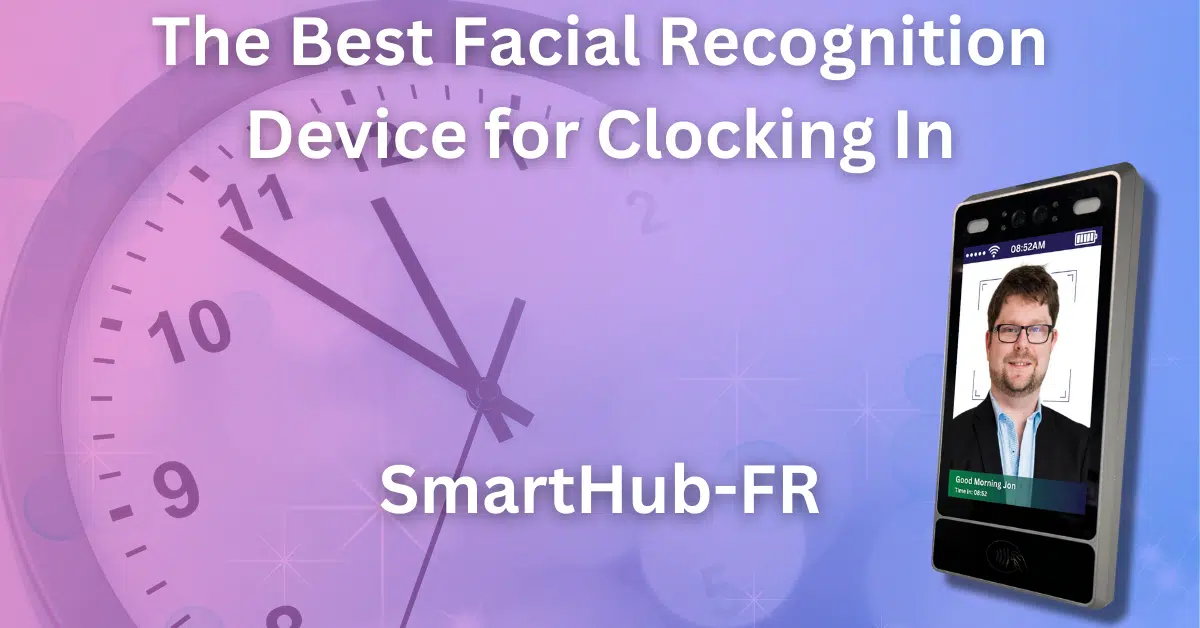In the rapidly evolving landscape of workforce management, facial recognition technology stands out for its efficiency and accuracy in employee time tracking. The SmartHub-FR by ClockedIn is a cutting-edge solution designed to revolutionise how businesses monitor and manage employee attendance. This article explores the innovative features of the SmartHub-FR and explains why it is the best facial recognition device for clocking in.

At the forefront of technological advancement, the SmartHub-FR integrates sophisticated facial recognition technology with the latest software developments to modernise the process of clocking in and out. Running on Android 11, the SmartHub-FR provides a seamless and secure attendance tracking solution. It employs advanced facial recognition algorithms that capture and analyse unique facial features in milliseconds, offering a swift and highly accurate check-in process.
This device enhances security and operational efficiency by encrypting captured data using AES 256-bit encryption, ensuring the protection of personal information. The recognition process is not only fast but also highly reliable, reducing the likelihood of fraud such as buddy punching and ensuring an accurate record of employee attendance.
The SmartHub-FR is distinguished in the marketplace by its robust set of features that cater to the dynamic needs of contemporary workplaces:
The professional installation begins with a site visit by a ClockedIn team member, who will assess your chosen location to ensure it meets operational requirements. Following this, the team member will expertly install and configure the SmartHub-FR, making certain that it is fully operational and securely connected to your network. This hands-on approach ensures that the SmartHub-FR is set up for immediate use, with minimal disruption to your daily operations, allowing you to start tracking time more efficiently and securely right away.
With its advanced facial recognition technology, the SmartHub-FR drastically improves the security and privacy of the workplace. The authentication process is precise and quick, significantly enhancing the accuracy of time tracking. This precision aids in effective payroll management and compliance with labour regulations, fostering a trustworthy environment for both employers and employees.
Data privacy and security are paramount in today’s digital age. The SmartHub-FR addresses these concerns head-on by incorporating AES 256-bit encryption to safeguard facial biometric data. This level of security ensures that sensitive information is protected against unauthorised access, with data used exclusively for attendance verification.
ClockedIn provides premium level support through various channels, including live chat, phone, and email, ensuring that any issues are addressed promptly and efficiently. For more complex problems, on-site support is available to ensure that your SmartHub-FR continues to function optimally.
The SmartHub-FR by ClockedIn represents a significant advancement in employee time tracking and workforce management. By harnessing the power of facial recognition technology, it offers a comprehensive solution that enhances operational efficiency, secures data privacy, and streamlines administrative processes. As businesses prepare for the future, the SmartHub-FR stands ready as a robust platform that not only tracks time but also empowers strategic decision-making and operational excellence.
In the rare case of non-recognition, the SmartHub-FR provides alternative verification methods and logs the attempt for administrative review.
The device operates effectively offline by storing data locally and syncing with the cloud once connectivity is restored.
While primarily designed for indoor use, ClockedIn can advise on measures to protect and optimise the device for outdoor settings.

Address: Suite 6 Empingham House, Uppingham Gate, Uppingham, LE15 9NY
Tel: 0203 371 1006